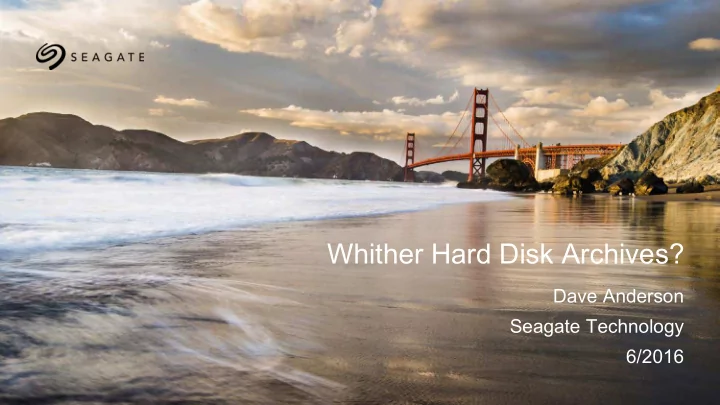

Whither Hard Disk Archives? Dave Anderson Seagate Technology 6/2016
Topics as They Relate to Large Storage Archives Where Topology might go Basic HDD Topologies – advantages & disadvantages • Hyper converged • Networked Storage Networking Considerations Where Capacity might go • Platter capacity = areal density • Platter size • Platter count = New form factors Where Intelligence might go One more thing
(Hyper)converged Architectures Combine in a single system unit: • Processors & memory • Storage • Networking Advantages • Interface & architecture simplicity • Local storage management Disadvantages • Cost – CPU complex for each set of HDDs • Inflexibility – limited variability in CPUs/HDDs relationship • A more complex cooling problem, perhaps
Networked Storage Common Storage Pool: • Attached via network to processors Advantages • Lower cost, no storage servers • More redundancy freedom • More freedom in CPUs/HDDs investment • Simplifies software stack (no storage servers) • Perhaps lower latency Disadvantages • Management practice not as developed • Not as well developed a software stack • Network picture not fully developed • Relatively high latency interface • Need low latency network for shared SSDs
What about that Networking Part of Networked Storage? Today’s choices: Ethernet, Infiniband, Fibre Channel • Ethernet has software-based protocol processing = more overhead • Nondeterministic overhead – occasional dropped frames • Infiniband not nearly as widely deployed, not an HDD interface Need: low latency network (no good choice today) • Enables networked, shared solid state storage option • PCIe does not scale well • Cannot connect large numbers of drive economically • No good dual port (yet) • Ideal low latency network would support: • Link types: optical & electronic • Protocol types: blocks & objects Where could this go? Check out UC Berkeley’s FireBox concept
Where Areal Density Might Go: CMR+TDMR HAMR HDMR SMR+TDMR Shingled Magnetic HAMR+TDMR HAMR+BPM 2D Magnetic Perpendicular Recording (SMR) Recording HAMR+SMR+TDMR Magnetic Recording +SMR+TDMR 16-18TB Heat Assisted <16 TB Heated Dot Compatible with PMR, AD Up to ~1.4 Tb/in 2 Magnetic Recording SMR and HAMR Magnetic Recording AD Up to ~1.0 Tb/in 2 20+% AD increase 30-60TB 10%+ AD increase 60-120TB Current Mainstream over PMR over base recording AD ~4.0 to 10.0 Tb/in 2 AD ~1.2 to 4.0 Tb/in 2 Products technology Ramping Initial Product Initial Product Product Integration Integration >2021 Integration 2018 2016
More Capacity per HDD: The Form Factor Factor History is littered with old HDD form factors: • >5.25” - 5.25”– 3.5” – 2.5” – 1.8” – 1.x” •Just because you built it in the past , •doesn’t mean you can build it again Helium enables more platters in current form factor A New Form factor is VERY expensive •Changes in cabinets & chassis •Changes in Component suppliers’ products •Changes in drive manufacturing Most feasible is not changing media size •3.5” x 1.6”? 3.5” x 1.6” 3.5” x 1.0”
One More Thing: Placing a little Computing Power with the Data Enable application processing at the storage device (HDD & SSD) First - sort of - product by ICL in 1979 Published in 3 academic research papers in 1998-2000 Why now: Movement to unstructured data Massive data sets Movement to storage objects 8
Active Disks: to Scale Search with the Data Size App I/O App I/O App I/O App HDD Improving Fast HDD App App App App I/O I/O I/O Performance SSD App App App App Active Disks Motivation of this architecture: Application Servers ●Parallelize analysis of data ●Reduce host data transfers ●Reduce application run time Ethernet network Scale data processing with data size! ●Note the effect of spreading data across more drives! ●May impel wide declustering of data 9
Research Papers From Archaya: http://www.vldb.org/conf/1998/p062.pdf Other papers: http://www.cs.umd.edu/~hollings/cs818z/s99/papers/activeDisks.pdf http://redbook.cs.berkeley.edu/redbook3/idisk.pdf Quantifying the Active Disk Benefit Execution time Reduction: 4 active disks: up to 60% 32 active disks: up to 95%! 10
Summary (Hyper)converged - today’s dominant topology Strong interest in Networked Storage • Several issues need addressing: • Holds a promise of enabling new architectures Areal density (capacity per platter) will be increasing New form factors are expensive, choosing one cannot be done lightly Large Archive focused innovation looms over the horizon
Recommend
More recommend